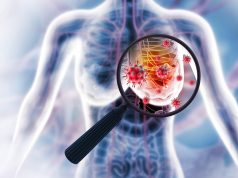Reductions in breast cancer mortality linked to screening and treatment, but associations vary
TUESDAY, Jan. 9, 2018 (HealthDay News) — The contributions of screening and treatment to decreases in breast cancer mortality vary by molecular subtype, according to a study published in the Jan. 9 issue of the Journal of the American Medical Association.
Sylvia K. Plevritis, Ph.D., from Stanford University in California, and colleagues examined the contributions of screening and treatment to breast cancer mortality reductions by molecular subtype based on estrogen-receptor (ER) and human epidermal growth factor receptor 2 (ERBB2) in women aged 30 to 79 years.
The researchers found that the estimated reduction in the overall breast cancer mortality rate was 37 percent in 2000 relative to the estimated baseline rate of 64 deaths per 100,000 women; of this reduction, 44 and 56 percent were associated with screening and treatment, respectively. The estimated reduction in overall breast cancer mortality rate was 49 percent in 2012 relative to the estimated baseline rate of 63 deaths per 100,000 women; 37 and 63 percent of this reduction were associated with screening and treatment, respectively. There was variation in the estimated relative contributions associated with screening versus treatment by molecular subtype: 36 versus 64 percent for ER+/ERBB2−, 31 versus 69 percent for ER+/ERBB2+, 40 versus 60 percent for ER−/ERBB2+, and 48 versus 52 percent for ER−/ERBB2−.
“Decreases in overall breast cancer mortality from 2000 to 2012 were associated with advances in screening and in adjuvant therapy, although the associations varied by breast cancer molecular subtype,” the authors write.
Several authors disclosed financial ties to the biotechnology and statistics research industries.
Copyright © 2018 HealthDay. All rights reserved.








